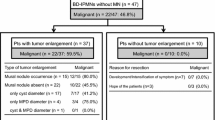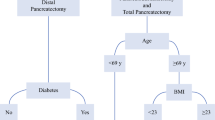Abstract
The objective of the study was to evaluate the Fukuoka guidelines in indicating the proper management for recognising the risk factors of malignancy. Data of patients with branch duct intraductal papillary mucinous neoplasms who underwent pancreatic resection or surveillance according to the Fukuoka risk parameters were collected in a prospective database. The clinical outcome (development of pancreatic cancer, overall and disease-specific survival) and pathological results were evaluated in all patients and in resected cases, respectively. The data of 197 patients were collected: 23 primarily resected and 174 primarily followed. Of the latter, 16 were secondarily resected. Among the patients resected, 21 (53.9%) showed diagnosis of in situ or invasive carcinoma and only contrast-enhancing mural nodules were significantly related to malignancy (P = 0.002), with a DOR of 3.3 and an LH+ of 2.2. Development of pancreatic cancer was shown in ten (5.7%) of the patients primarily followed. The overall survival and disease-specific survival were similar between patients primarily followed and primarily resected. It seems reasonable to suggest that a branch duct intraductal papillary mucinous neoplasm should be treated as a benign and indolent disease that is rarely malignant. Enhancing mural nodules represent the best indicator for surgery.




Similar content being viewed by others
References
Sohn TA, Yeo CJ, Cameron JL, Hruban RH, Fukushima N, Campbell KA et al (2004) Intraductal papillary mucinous neoplasms of the pancreas: an updated experience. Ann Surg 239(6):788–797
Poultsides GA, Reddy S, Cameron JL, Hruban RH, Pawlik TM, Ahuja N et al (2010) Histopathologic basis for the favorable survival after resection of intraductal papillary mucinous neoplasm-associated invasive adenocarcinoma of the pancreas. Ann Surg 251(3):470–476
Tanaka M, Fernández-del Castillo C, Adsay V, Chari S, Falconi M, Jang JY et al (2012) International consensus guidelines 2012 for the management of IPMN and MCN of the pancreas. Pancreatology 12(3):183–197
Anand N, Sampath K, Wu BU (2013) Cyst features and risk of malignancy in intraductal papillary mucinous neoplasms of the pancreas: a meta-analysis. Clin Gastroenterol Hepatol 11:913–921
Kim KW, Park SH, Pyo J, Yoon SH, Byun JH, Lee MG et al (2014) Imaging features to distinguish malignant and benign branch-duct type intraductal papillary mucinous neoplasms of the pancreas: a meta-analysis. Ann Surg 259(1):72–81
Ricci C, Casadei R, Taffurelli G, Zani E, Pagano N, Pacilio CA, Ingaldi C, Bogoni S, Santini D, Migliori M, Di Marco M, Serra C, Calculli L, De Giorgio R, Minni F (2016) Risk factors for malignancy of branch-duct intraductal papillary mucinous neoplasms. A critical evaluation of the fukuoka guidelines with a systematic review and meta-analysis. Pancreas 45:1243–1254
Pelaez-Luna M, Chari ST, Smyrk TC, Takahashi N, Clain JE, Levy MJ, Pearson RK, Petersen BT, Topazian MD, Vege SS, Kendrick M, Farnell MB (2007) Do consensus indications for resection in branch duct intraductal papillary mucinous neoplasm predict malignancy? A study of 147 patients. Am J Gastroenterol 102:1759–1764
Ohtsuka T, Kono H, Nagayoshi Y, Mori Y, Tsutsumi K, Sadakari Y, Takahata S, Morimatsu K, Aishima S, Igarashi H, Ito T, Ishigami K, Nakamura M, Mizumoto K, Tanaka M (2012) An increase in the number of predictive factors augments the likelihood of malignancy in branch duct intraductal papillary mucinous neoplasm of the pancreas. Surgery 151:76–83
Seo N, Byun JH, Kim JH, Kim HJ, Lee SS, Song KB et al (2016) Validation of the 2012 International Consensus Guidelines using computed tomography and magnetic resonance imaging branch duct and main duct intraductal papillary mucinous neoplasms of the pancreas. Ann Surg 263:557–564
Sahora K, Mino-Kenudson M, Brugge W, Thayer SP, Ferrone CR, Sahani D et al (2013) Branch duct intraductal papillary mucinous neoplasms. Does cyst size change the tip of the scale? A critical analysis of the revised International Consensus Guidelines in a large single-Institutional series. Ann Surg 258:466–475
Fritz S, Klauss M, Bergmann F, Hackert T, Hartwig W, Strobel O et al (2012) Small (Sendai negative) branch-duct IPMNs: not harmless. Ann Surg 256(2):313–320
Roch AM, DeWitt JM, Al-Haddad MA, Schmidt CM, Ceppa EP, House MG et al (2014) Nonoperative management of main pancreatic duct-involved intraductal papillary mucinous neoplasm might be indicated in select patients. J Am Coll Surg 219(1):122–129
Hruban RH, Takaori K, Klimstra DS, Adsay NV, Albores-Saavedra J, Biankin AV et al (2004) An illustrated consensus on the classification of pancreatic intraepithelial neoplasia and intraductal papillary mucinous neoplasms. Am J Surg Pathol 28:977–987
Tanaka M, Chari S, Adsay V, Fernandez-del Castillo C, Falconi M, Shimizu M et al (2006) International Consensus Guidelines for management of intraductal papillary mucinous neoplasms and mucinous cystic neoplasms of the pancreas. Pancreatology 6:17–32
Vege SS, Ziring B, Jain R, Moayyedi P, The Clinical Guidelines Committee (2015) American Gastroenterological Association Institute Guideline on the diagnosis and management of asymptomatic neoplastic pancreatic cysts. Gastroenterology 148:819–822
Sugiyama M, Atomi Y (1998) Intraductal papillary mucinous tumors of the pancreas: imaging studies and treatment strategies. Ann Surg 228:685–691
Taouli B, Vilgrain V, Vullierme MP, Terris B, Denys A, Sauvanet A et al (2000) Intraductal papillary mucinous tumors of the pancreas: helical CT with histopathologic correlation. Radiology 217:757–764
Sahani DV, Kadavigere R, Blake M, Fernandez-Del Castillo C, Lauwers GY, Hahn PF (2006) Intraductal papillary mucinous neoplasm of pancreas: multi-detector row CT with 2D curved reformations—correlation with MRCP. Radiology 238:560–569
Longnecker DS, Adler G, Hruban RH (2000) Intraductal papillary-mucinous neoplasms of the pancreas. In: Hamilton SRAL (ed) World Health Organization classification of tumors pathology and genetics of tumors of the digestive system: lyon. IARC Press, France, pp 237–241
Irwig L, Bossuyt P, Glasziou P, Gatsonis C, Lijmer J (2002) Designing studies to ensure that estimates of test accuracy are transferable. BMJ 324(7338):669–671
Levy P, Jouannaud V, O’Toole D, Couvelard A, Vullierme MP, Palazzo L et al (2006) Natural history of intraductal papillary mucinous tumors of the pancreas: actuarial risk of malignancy. Clin Gastroenterol Hepatol 4:460–468
Nagata N, Kawazoe A, Mishima S, Wada T, Shimbo T, Sekine K et al (2016) Development of pancreatic cancer, disease-specific mortality and all-cause mortality in patients nonresected IPMNs: a long-term cohort study. Radiology 278:125–134
Crippa S, Capurso G, Cammà C, Delle Fave G, Fernandez-del Castillo C, Falconi M (2016) Risk of pancreatic malignancy and mortality in branch-duct IPMNs undergoing surveillance: a systematic review and meta-analysis. Dig Liv Dis 48:473–479
Author information
Authors and Affiliations
Contributions
All the authors have participated sufficiently in the work according the guidelines of the International Committee of Medical Journal Editors (ICMJE).
Corresponding author
Ethics declarations
Funding
No funding were received for the study.
Disclosure
There is no commercial interest, financial source or material support to disclose.
Conflict of interest
Riccardo Casadei and the other co-authors decalre that they have no conflict of interest.
Research involving human participants and/or animals
All procedures performed in the study involving human participants were in accordance with the ethical standard of the institutional and/or national research committee and with the 1964 Helsinky declaration and its later amendments or comparable ethical standards.
Informed consent
Iinformed consent was obtained from all individual participants included in the study.
Rights and permissions
About this article
Cite this article
Casadei, R., Ricci, C., Taffurelli, G. et al. Impact of surgery and surveillance in the management of branch duct intraductal papillary mucinous neoplasms of the pancreas according to Fukuoka guidelines: the Bologna experience. Updates Surg 70, 47–55 (2018). https://doi.org/10.1007/s13304-017-0471-7
Received:
Accepted:
Published:
Issue Date:
DOI: https://doi.org/10.1007/s13304-017-0471-7




